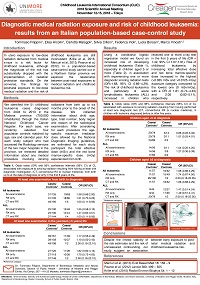Abstract
Introduction: In utero exposure to low-dose radiation delivered from medical procedures is a risk factor for childhood leukemia (CL), while findings for postnatal exposure are scarce and still inconsistent. In a population-based case-control study carried out in a Northern Italian province we explored the relationship between post-natal exposures to medical radiation and CL risk.
Methods: We identified CL cases diagnosed in the Modena province in the period 2004-2013 through the Italian National Childhood Cancer Register and we randomly selected four population controls matched by age, sex and calendar year. For each subject we retrieved detailed information about any medical procedure involving ionizing radiations from birth up to six months prior to the onset of the disease by accessing to databases of the Radiology services of Modena province. We collected information about child age, type, total number, body region and reason of the radiological examination. Finally, we estimated for each study participant the total effective dose (mSv) and the red bone marrow-specific dose (mGy) experienced from birth.
Results: Using a conditional logistic regression model we found an increased risk of developing CL, especially in children aged 5 or more, in association with experiencing one or more diagnostic tests with ionizing radiation (odds ratio 1.68, 95% confidence interval 0.66–4.29). The risk of CL and particularly of acute lymphoblastic leukemia increased in children who received one or more x-ray test in the first 5 years of life. Risk of CL by increasing total effective dose and red bone marrow-specific dose increased in the highest (>0.035 mSv and >0.0125 mGy) compared to null exposure.
Conclusions: Our study suggests an increased risk of CL related to early exposure to post-natal medical radiation.

